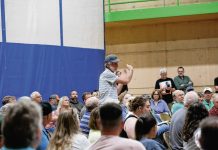Atterbury-Bakalar Air Museum has launched a crowdfunding campaign to bring a Fairchild C-119 Flying Boxcar aircraft to Columbus.
The campaign, which is sponsored by the Indiana Housing and Community Development Authority, seeks to raise $50,000 to transport, stage and adapt the plane for public use.
If $50,000 is raised by July 21, the project will receive a $50,000 matching grant from the Indiana Housing and Community Development Authority’s CreatINg Places program, the state’s crowdfunding grant program.
"We’re trying to create another destination out at the air park to get people to come out to learn more about the airport and learn about its history," said Brian Payne, Columbus Municipal Airport director.
[sc:text-divider text-divider-title=”Story continues below gallery” ]Click here to purchase photos from this gallery
The C-119, also known as the "Flying Boxcar" due to the unusual shape of its fuselage, was in service with the U.S. Air Force from 1947 to 1972 and was designed to carry cargo, personnel, litter patients and mechanized equipment. The aircraft was also used to drop cargo and troops using parachutes, according to the Strategic Air Command and Aerospace Museum.
The aircraft weighs approximately 40,000 pounds and is about 86 feet long, has a 109-foot wingspan and is 26 feet tall at the tail. The Flying Boxcars were powered by two Wright R-3350 Duplex Cyclone radial engines, each with 3,400 horsepower, and could reach a maximum speed of 296 miles per hour.
The U.S. Air Force extensively used C-119s during the Korean War from 1950 to 1953.
One notable mission occurred in 1950 when eight C-119Bs air-dropped a portable bridge to allow U.S. troops to escape some 120,000 communist forces who had pinned them in near Chosin Reservoir in present-day North Korea. The air-dropped bridge replaced a bridge over a steep chasm that had been destroyed, allowing thousands of soldiers an escape route.
Retired C-119s were also used as air tankers to fight wildfires in the United States.
The Flying Boxcars are of particular historical significance to Columbus, according to museum volunteers. Here, the pilots referred to them as the "Dollar Nineteens," according to museum records.
From 1957 to 1969, 36 C-119s for the 434th Troop Carrier Wing were stationed at Bakalar Air Force Base, which is now Columbus Municipal Airport. The C-119s were a staple in Columbus, flown out of the base longer than any other aircraft.
"It’s an important part of the history of the former air base in Columbus," said Nick Firestone, Atterbury-Bakalar Air Museum Board president. "People who lived in the Columbus area anywhere from the mid-’50s to 1970 when the base closed are very familiar with these planes because they would see them flying around for training purposes."
Manufacturers Fairchild and Kaiser built 1,151 of the C-119s from 1949 to 1955. However, only around 40 Flying Boxcars are still left today, most of them in museums across the country, Firestone said.
The Atterbury-Bakalar Air Museum purchased the aircraft for $15,000 on May 8 from a private owner in Greybull, Wyoming, Firestone said.
The plane, which is not airworthy, is at an airport in Greybull. Because the airplane cannot be flown to Columbus, it needs to be taken apart, loaded onto semis and driven some 1,460 miles to Columbus, where it will be reassembled, restored and put on public display, museum volunteers said.
The aircraft will be installed on the west side of Bakalar Green, along Ray Boll Boulevard, just south of the McDonnell Douglas F-4 Phantom II aircraft that is currently on display. Museum officials said they hope to have the aircraft in Columbus by this fall and have it restored and completely ready for the public by Aviation Day in June 2020.
The C-119 that the museum purchased was previously used for firefighting and will be modified to resemble the way it looked when used by the military, said Firestone. Museum officials do not believe this particular aircraft acquired by the museum was ever stationed in Columbus.
Payne said museum officials had been on the lookout for a C-119 for around 15 years until he inadvertently discovered the one for sale in Wyoming on the internet.
After he told museum officials about the aircraft, they inquired about purchasing it. Though the museum did not purchase the aircraft Payne initially discovered, the aircraft’s owner pointed museum officials to Greybull, where at least seven of the remaining 40 C-119s in the world are now located.
"There’s only about 40 of these things left," Firestone said. "Most of them are in museums or in a scrap yard and have been cannibalized."
Greybull has become somewhat of a hot spot for the Flying Boxcars because it is the home of the Museum of Flight and Aerial Firefighting.
Atterbury-Bakalar Air Museum officials initially also considered purchasing other Flying Boxcars that were for sale in Georgia and Nevada, Firestone said. Columbus Municipal Airport donated $15,000 to the museum so it could purchase the aircraft in Greybull, Payne said.
[sc:pullout-title pullout-title=”For more information” ][sc:pullout-text-begin]
Visit patronicity.com/project/charlie_119#!/ for more information about the project or to contribute to the campaign.
[sc:pullout-text-end][sc:pullout-title pullout-title=”C-119 Flying Boxcar specs” ][sc:pullout-text-begin]
C-119G SPECIFICATIONS
- Span: 109 ft. 3 1/4 in.
- Length: 86 ft. 5 3/4 in.
- Height: 26 ft. 7 3/4 in.
- Weight: 66,900 pounds max.
- Armament: None
- Engines: Two Wright R-3350s of 3,500 hp. each.
- Cost: $590,000
PERFORMANCE
- Maximum speed: 290 mph.
- Cruising speed: 200 mph.
- Range: 2,000 miles
- Service Ceiling: 30,000 ft.
[sc:pullout-text-end]




